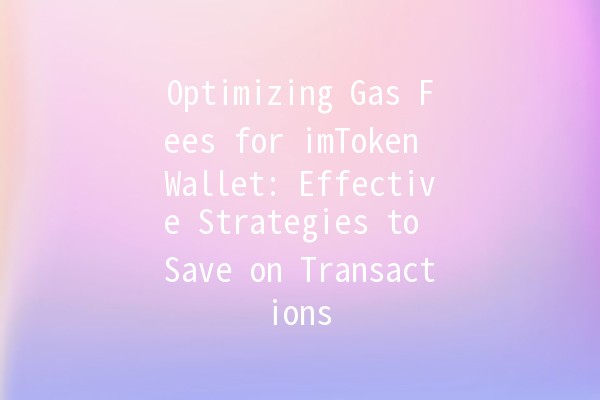In the realm of cryptocurrency, managing costs is crucial for maximizing profits, and gas fees are a significant part of that equation. Gas fees refer to the charges required to perform transactions on the Ethereum network and other blockchain platforms. For users of the imToken wallet, understanding how to optimize these fees can lead to substantial savings. This article delves into practical strategies and tips that can help you efficiently manage gas fees while using the imToken wallet.
Before we dive into optimization techniques, it is essential to understand what gas fees are. Gas limits and gas prices determine the amount you pay to have your transaction processed. The gas price is measured in Gwei, which is a denomination of Ethereum (1 ETH = 1 billion Gwei). When you initiate a transaction, the complexity of that transaction and the current demand for network resources can impact the gas fees.
To minimize expenses while using the imToken wallet, consider the following effective strategies:

The timing of your transactions can significantly impact gas fees. During peak hours, the demand for transactions is high, leading to increased costs. To save money:
Monitor Network Activity: Use platforms like ETH Gas Station or Blocknative to check current gas prices.
Choose OffPeak Times: Execute transactions when the network is less congested, typically during weekends or late at night.
If you observe that gas prices drop significantly during weekends, plan to conduct your transactions during this time to take advantage of lower fees.
Gas limits are another crucial aspect of gas fees. Setting appropriate gas limits can prevent overpayment. A transaction may fail if the gas limit is too low, but a higher limit doesn't guarantee quicker processing.
Set a Reasonable Gas Limit: For simple transactions, a gas limit around 21,000 is common. For more complex transactions, research the average gas consumption for similar transactions.
Adjust Dynamically: If your transaction is urgent but costs are reasonable, increase the gas price rather than the limit.
If a token swap transaction typically uses 50,000 gas, set your gas limit slightly above this figure to ensure successful execution without excessive overcharges.
The imToken wallet provides various features that can assist in managing gas fees effectively:
Smart Transaction Features: imToken features algorithms that can optimize gas fee settings automatically based on current network conditions.
Gwei Architect: This tool allows users to select their preferred gas prices, offering choices based on transaction urgency.
By selecting the "slow" gas price option on imToken when the network isn't busy, users can significantly reduce transaction costs.
If you often send multiple transactions, consider batching them. This method allows you to combine multiple transactions into a single one, reducing the overall gas cost.
Use Smart Contracts: Implement smart contracts to facilitate batch transactions in a single operation, saving you the need to pay separate gas fees for each transaction.
Instead of sending five transactions separately, use a smart contract to send them all at once, resulting in a lower total gas fee.
Layer 2 solutions like Optimistic Rollups and zkRollups can significantly lower gas fees by processing transactions offchain before confirming them on the main Ethereum network.
Use Layer 2 Protocols: If you regularly use decentralized applications (dApps) for transactions, consider connecting your imToken wallet to a Layer 2 solution that supports reduced gas fees.
Using Optimism or Arbitrum can yield much lower transaction costs compared to direct Ethereum transactions, allowing users to save on gas.
Gas fees are the fees you pay to conduct transactions on the blockchain network. They compensate miners for the computational energy required to validate transactions. In the imToken wallet, these fees are paid in Ethereum (ETH).
Gas fees are calculated based on two variables: gas price (in Gwei) and gas limit. The total fee is derived from multiplying these two factors. For example, if the gas price is 50 Gwei and the transaction uses a gas limit of 21,000, the total fee would be:
Total Fee = (Gas Price in Gwei) x (Gas Limit) = 50 Gwei * 21,000 = 1,050,000 Gwei (or 0.00105 ETH).
Once a transaction is submitted on the blockchain, it cannot be altered. However, you can speed up a transaction in the imToken wallet by selecting a higher gas price, provided the transaction remains pending.
Gas price is crucial as it directly affects how quickly your transaction gets processed on the network. If you set a low gas price during peak times, your transaction may face delays or may not be mined at all.
To avoid overpaying:
Monitor network activity using gas tracking tools.
Set reasonable gas limits, based on average usage.
Utilize insights and features provided by the imToken wallet.
While using the imToken wallet itself does not incur fees, you will need to pay gas fees for conducting transactions on the network. Always ensure you have enough ETH in your wallet to cover these fees.
Optimizing gas fees when using the imToken wallet can lead to significant cost savings, especially for frequent users. By timing your transactions strategically, understanding gas limits, leveraging the wallet’s features, batching transactions, and considering Layer 2 solutions, you can navigate the intricacies of cryptocurrency transactions more efficiently. Knowledge is your best tool in the everevolving landscape of digital assets, and these strategies will keep you ahead.
By implementing these techniques and continuously monitoring the network conditions, you'll not only save money but also enhance your overall cryptocurrency trading experience.